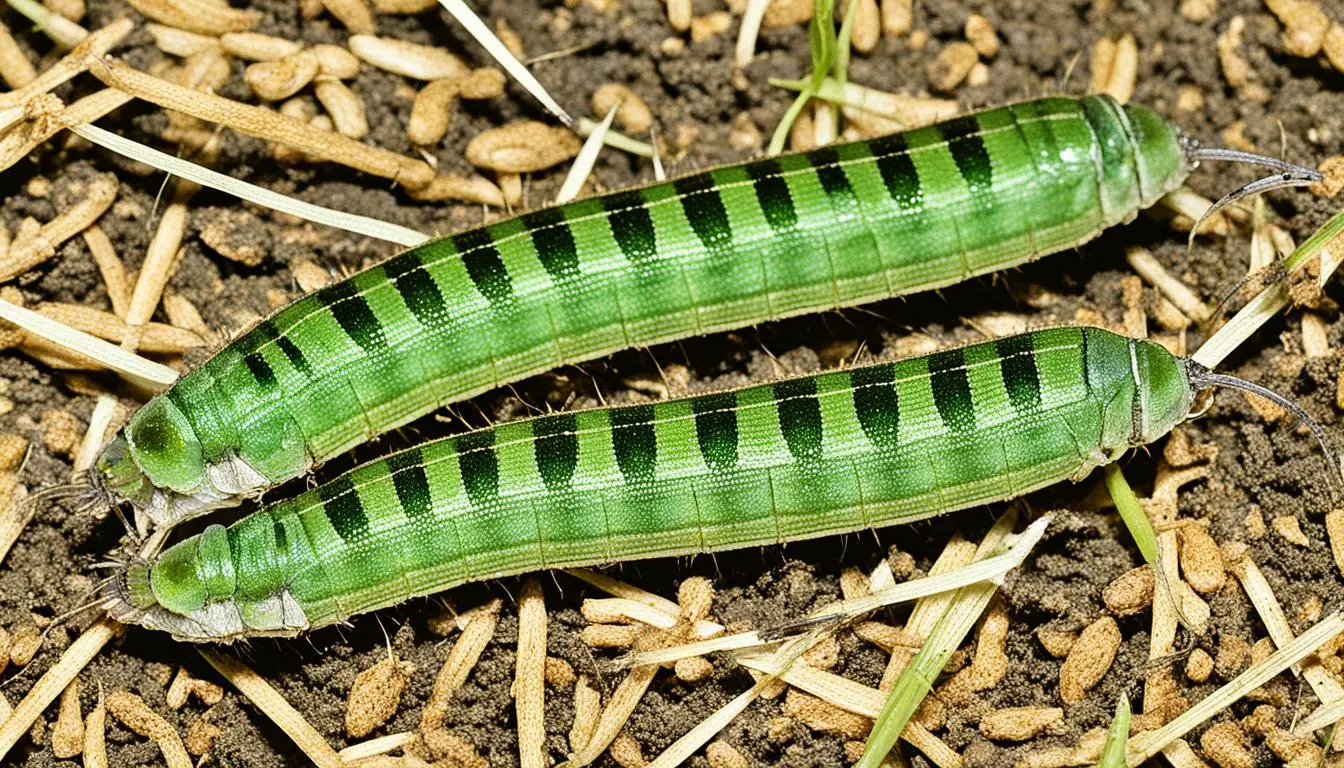Armyworms can destroy your garden very quickly. They look like caterpillars, eat a lot, and move in big groups. They eat plants so fast that you can see the damage they cause in a short time. You can deal with them using safe and natural methods.
These larvae look different depending on their species and age. They can be yellow, green, gray, or brown. When they eat a plant, only the hard parts are left. Armyworms like young plants such as beans and peas or big crops like corn and soybeans.
Most armyworms eat at night, which is why you might see the damage in the morning. But, there are peaceful ways to stop them from ruining your plants. You can remove them by hand, use safe sprays, or invite helpful insects to your garden. These methods work well to keep armyworms away.
What are Armyworms?
Armyworms are the early stage of moths in the Noctuidae family. They stand out with an “Y” shape on their head and long, dark stripes. These insects can be up to 2 inches long and often curl up when they feel threatened.
Appearance and Behavior
Armyworms look like typical worms at first but grow into gray, speckled moths. These moths fly around at night. But it’s the larvae that cause a lot of damage to plants.
Life Cycle
It starts when female moths lay hundreds of eggs. The eggs hatch into larvae that eat a lot for 3-4 weeks. Then, they burrow into the soil to become moths and start the cycle again.
Common Host Plants
These pests eat a lot and like plants such as beans, peas, lettuce, and spinach. They also attack crops like corn and soybeans. Even some grass types are not safe from them. They mostly target young, soft plants, which is bad news for gardens and lawns.
How to Get Rid of Armyworms in the Garden
Dealing with armyworms in the garden has many organic solutions. Handpick them off plants or use beneficial bugs. It’s best to mix different methods together to beat these damaging bugs.
Handpicking and Drowning
To start, remove armyworms by hand from your plants. Look under leaves for them. Drop the armyworms in a bucket of soapy water to drown them. Doing this is easier in small gardens.
Applying Neem Oil
Neem oil is great at getting rid of armyworms. Follow the directions to make a neem oil mix. Spray it on plants well. This oil makes the plants less tasty for the armyworms.
Introducing Beneficial Insects
Get helpful bugs like lacewings, ground beetles, and parasitic wasps in your garden. They eat the armyworms. These helpful insects can be brought in by planting specific plants or by buying them.
Using Bacillus thuringiensis (Bt)
Bacillus thuringiensis (Bt) is good for getting rid of armyworms. Use it as told on the package. It only hurts caterpillars, not good bugs or wildlife.
Spinosad Application
Spinosad is also a good choice for getting rid of armyworms. It’s natural and made from bacteria in the soil. Spray it on plants, following the directions closely.
Inorganic Insecticides (Last Resort)
Only use chemical pesticides as a last choice. They can kill armyworms, but they’re not the best for the environment. Use them carefully after trying everything else.

Preventing Future Armyworm Infestations
After beating an armyworm infestation, it’s crucial to prevent their return. A tidy garden is key because armyworms love hiding in plant debris. By keeping your garden clean, you make it less friendly for these pests. Also, placing pheromone traps can disrupt the adult moths’ habits, reducing the chance of a new armyworm generation. This makes it harder for them to lay eggs near your plants.
Maintaining a Clean Garden
Cleaning your garden regularly, like removing fallen leaves, stops armyworms from settling in. It’s vital to keep the soil clean of organic matter where armyworm eggs or larvae could hide. Regularly looking after your garden is essential for keeping armyworms away.
Setting Pheromone Traps
Putting up pheromone traps on your garden’s edge can disrupt moth breeding. These traps use a female armyworm’s scent to attract and catch males. This lowers the chance of moth reproduction, helping prevent future armyworm infestations. So, placing these traps strategically is effective in controlling armyworms.
Attracting Birds with Feeders
Encouraging birds that eat armyworms is one of the best eco-friendly armyworm remedies. Setting bird feeders and baths will attract birds like blackbirds and sparrows. These birds are natural armyworm predators and reduce the armyworm population. This is another companion planting for armyworm deterrence method.
Using Floating Row Covers
Using floating row covers on your plants can stop adult armyworm moths from laying eggs. This is a great way to protect young plants and seedlings. The covers let in air, light, and water while keeping pests away. It’s a smart preventative measure against armyworms.

Identifying Common Armyworm Species
Knowing the types of armyworms is key to managing them in your garden or on crops. Let’s look at some familiar armyworms you might see.
Fall Armyworm
The fall armyworm, or Spodoptera frugiperda, is a big problem for farmers. They destroy corn, sorghum, and grass crops. You can spot them by their white, inverted “Y” markings on their heads. They come in colors from light green to dark brown. These worms are a major issue in the south of the U.S.
Beet Armyworm
The beet armyworm, Spodoptera exigua, loves many plants, like beets, spinach, and tomatoes. Look for them by the dark spots on their bodies. They are usually green or brown.
True Armyworm
The true armyworm, Mythimna unipuncta, is found everywhere and damages grasses and crops. They have that telltale inverted “Y” on their heads. You’ll see them in shades from light green to brown.
Southern Armyworm
The southern armyworm, Spodoptera eridania, lives in the southern U.S. and eats crops like soybeans. Look for their dark head and green, brown, or black bodies.
Lawn Armyworm
The lawn armyworm, Spodoptera mauritia, is a troublemaker for lawns, golf courses, and fields. They are usually light green or brown with dark spots.
Conclusion
Armyworms are a big problem in gardens, eating plants fast and causing a lot of damage. But, you can get rid of them and stop them from coming back. Use natural ways like picking them off by hand, neem oil, helpful bugs, Bt, and spinosad.
Keeping your garden clean and using traps and covers also help. Know which type of armyworm is there for better control. With effort and smart tactics, you can protect your garden and have a beautiful, pest-free place.
By using natural methods and being proactive, you can have a healthy garden. You won’t need to use strong chemicals. Learn how to beat these bugs and have a garden that’s full of life, not armyworms.
FAQ
Q: What are armyworms and how do they affect gardens?
A: Armyworms are the larvae of moths in the Noctuidae family. They move in large groups and eat plants fast. This can cause a lot of damage in gardens, crops, and on lawns. They leave only tough tissue behind.
Q: What do armyworms look like?
A: Armyworms have a distinct look with an upside-down “Y” on their heads. They grow up to 2 inches long and have dark stripes. They curl when they feel threatened. As moths, they are gray with mottled patterns on their wings.
Q: How do armyworms reproduce and what is their life cycle?
A: Female armyworm moths lay lots of eggs at once. These eggs hatch into larvae that eat plants for 3-4 weeks. After this, they go into the soil to turn into moths. This cycle can happen many times in a single growing season.
Q: What plants are most susceptible to armyworm damage?
A: Armyworms like to eat young plants and agricultural crops. They particularly enjoy plants like beans, peas, lettuce, and corn. They eat so much they can destroy a plant but leave only the hard parts.
Q: How can I get rid of armyworms in my garden?
A: There are natural ways to deal with armyworms. You can pick them off by hand and put them in soapy water. Neem oil and beneficial insects are also helpful. Bacillus thuringiensis (Bt) and spinosad can be applied. Save using inorganic insecticides as a last choice.
Q: How can I prevent future armyworm infestations?
A: Keeping your garden clean and well-maintained is key to preventing armyworms. Cut back on dense plant debris where they hide. You can also use pheromone traps, bird feeders, and floating row covers. These methods can stop them from coming back.
Q: What are the common species of armyworms that can invade gardens?
A: Fall armyworm, beet armyworm, true armyworm, southern armyworm, and lawn armyworm are common in gardens and on farms. Knowing which armyworm is invading can help you manage them better.






